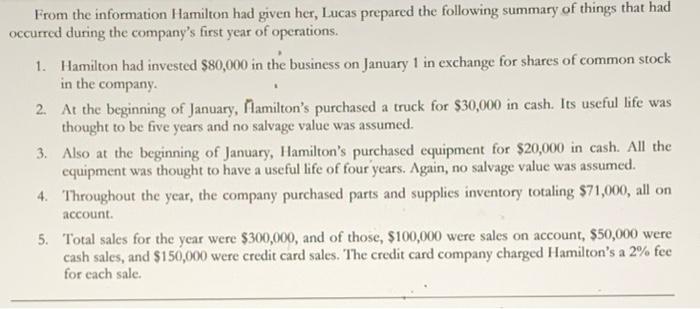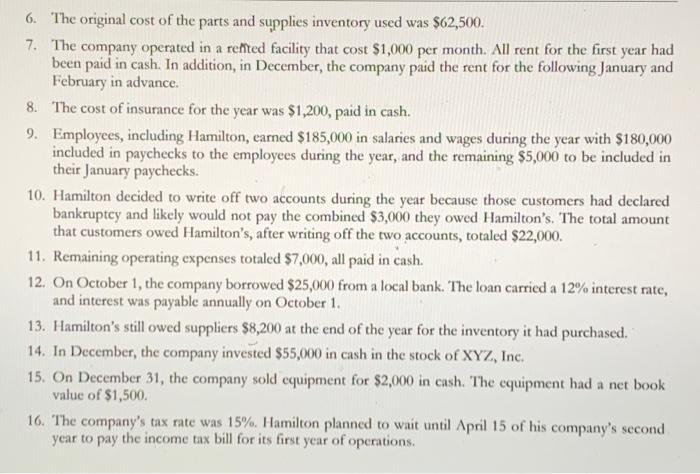Answered step by step
Verified Expert Solution
Question
1 Approved Answer
From the information Hamilton had given her, Lucas prepared the following summary of things that had occurred during the company's first year of operations.


From the information Hamilton had given her, Lucas prepared the following summary of things that had occurred during the company's first year of operations. 1. Hamilton had invested $80,000 in the business on January 1 in exchange for shares of common stock in the company. 2. At the beginning of January, flamilton's purchased a truck for $30,000 in cash. Its useful life was thought to be five years and no salvage value was assumed. 3. Also at the beginning of January, Hamilton's purchased equipment for $20,000 in cash. All the equipment was thought to have a useful life of four years. Again, no salvage value was assumed. 4. Throughout the year, the company purchased parts and supplies inventory totaling $71,000, all on account. 5. Total sales for the year were $300,000, and of those, $100,000 were sales on account, $50,000 were cash sales, and $150,000 were credit card sales. The credit card company charged Hamilton's a 2% fee for each sale. 6. The original cost of the parts and supplies inventory used was $62,500. 7. The company operated in a refited facility that cost $1,000 per month. All rent for the first year had been paid in cash. In addition, in December, the company paid the rent for the following January and February in advance. 8. 9. The cost of insurance for the year was $1,200, paid in cash. Employees, including Hamilton, earned $185,000 in salaries and wages during the year with $180,000 included in paychecks to the employees during the year, and the remaining $5,000 to be included in their January paychecks. 10. Hamilton decided to write off two accounts during the year because those customers had declared bankruptcy and likely would not pay the combined $3,000 they owed Hamilton's. The total amount that customers owed Hamilton's, after writing off the two accounts, totaled $22,000. 11. Remaining operating expenses totaled $7,000, all paid in cash. 12. On October 1, the company borrowed $25,000 from a local bank. The loan carried a 12% interest rate, and interest was payable annually on October 1. 13. Hamilton's still owed suppliers $8,200 at the end of the year for the inventory it had purchased. 14. In December, the company invested $55,000 in cash in the stock of XYZ, Inc. 15. On December 31, the company sold equipment for $2,000 in cash. The equipment had a net book value of $1,500. 16. The company's tax rate was 15%. Hamilton planned to wait until April 15 of his company's second year to pay the income tax bill for its first year of operations.
Step by Step Solution
★★★★★
3.50 Rating (163 Votes )
There are 3 Steps involved in it
Step: 1
Balance Sheet As of December 31Yea 1 Assets Current assets Cash 71800 Investments 55000 Accounts Rec...
Get Instant Access to Expert-Tailored Solutions
See step-by-step solutions with expert insights and AI powered tools for academic success
Step: 2

Step: 3

Ace Your Homework with AI
Get the answers you need in no time with our AI-driven, step-by-step assistance
Get Started


